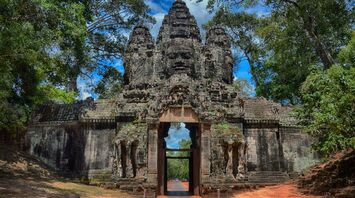This Ancient Temple in Laos Rivals Angkor Wat—Without the Crowds

With its stone ruins near a natural spring, the sprawling Vat Phou temple complex in Laos offers a less crowded yet equally mesmerizing alternative to Cambodia's Angkor Wat. Unlike Angkor, which attracts around six million tourists annually, Vat Phou remains a tranquil and rarely visited site, offering visitors a serene experience steeped in history and spirituality.
Both Vat Phou and Angkor Wat were built as religious centers during the Khmer era, from 802 to 1431 A.D., and are located along the Ancient Angkor Road. Vat Phou, recognized as a UNESCO World Heritage site, features lotus-filled reservoirs and carved stone pillars similar to Angkor Wat. However, Vat Phou predates Angkor Wat by several centuries, with foundational structures dating back to the fifth century.
How to Visit Vat Phou Temple
Located four miles outside the town of Champasak, Vat Phou straddles Lingaparvata (Linga Mountain), named for its phallus-like summit associated with the Hindu god Shiva. The temple complex spans hundreds of years, with local legends attributing its construction to King Kammatha in the first millennium A.D.
Visitors to the 96,000-acre site begin their journey between two large rectangular water reservoirs that lead to a broad esplanade with two Khmer-style stone buildings. These structures, designed for worship and rituals, feature gabled roofs and carved lintels depicting scenes from the Mahabharata.
As you move further into the complex, you'll encounter a crumbling shrine dedicated to Shiva’s Mount Nandi and climb stone steps with balustrades shaped like mythical river serpents (nagas). The upper sanctuary, carved with apsaras and Hindu gods, once held a large linga, replaced in the 13th century by a Buddha statue. The upper terrace offers staggering views of lush countryside crisscrossed by rice paddies and tiny villages extending to the Mekong River.
Exploring Beyond Vat Phou
While Vat Phou can be explored in less than a day, the Champasak region offers plenty more to see. The town of Champasak itself exudes mellow Indochinese charm with its riverside cafés and French colonial vestiges. Recently launched nature and archaeological trails guide visitors to temples and waterfalls, searching for remnants of the lost city Kurukshestra.
A local ferry takes visitors to Don Daeng, a Mekong River island with small settlements and fruit orchards. Across the river, Vat Tomo, a forest temple dedicated to Parvati, remains enveloped by the jungle.
An hour's drive from Champasak, the Xe Pian Nature Reserve offers primordial wetlands and forested hills. The Kingfisher Ecolodge provides bird-watching and wildlife excursions, while mysterious megalithic pillars and an abandoned garrison on Phou Asa mountain invite reflection.
North of Champasak, the Bolaven Plateau's rich volcanic soils support a thriving coffee industry. Indigenous mountain communities and social enterprises like Slow Forest Coffee are pioneering sustainable bean cultivation and reforestation programs.



















